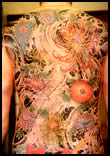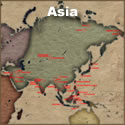Chinese & Taiwanese Tattooing5,000 BC
The earliest evidence of tattooing in Japan is found in the form of clay
figurines that have faces painted or engraved to represent tattoo marks. The
oldest figures of this kind have been recovered from tombs dated to 5,000 BC or
older.
297 AD
The first written record of Japanese tattooing is found when a Chinese dynastic
history was compiled. According to the text, Japanese "men young and old, all
tattoo their faces and decorate their bodies with designs." Japanese tattooing
is also mentioned in other Chinese histories, but always in a negative context.
The Chinese considered tattooing a sign of barbarism and used it only as
punishment.
18th Century
Pictorial
tattooing flourished during the eighteenth century in connection with the
popular culture of Edo, as Tokyo was then called. Early in the 18th century,
publishers needed illustrations for novels, theatres needed advertisements for
their plays and the Japanese wood block print was developed to meet these needs.
The development of the wood block print parallels, and had great influence on,
the development of tattooing. Because of the association between tattooing and
criminal activity, tattooing was outlawed on the grounds that it was "deleterious
to public morals."
Tattooing continued to flourish among firemen, laborers and others considered
to be at the lower end of the social scale. Tattoos were favored by gangs called
Yakuza, outlaws, penniless peasants, laborers and misfits who migrated to Edo in
the hope of improving their lives.
 The Yakuza felt that because tattooing was painful, it was a proof of
courage; because it was permanent, it was evidence of lifelong loyalty to the
group; and because it was illegal, it made them outlaws forever.
The Yakuza felt that because tattooing was painful, it was a proof of
courage; because it was permanent, it was evidence of lifelong loyalty to the
group; and because it was illegal, it made them outlaws forever.
Around the middle of the 18th century, the popularity of tattooing was
stimulated by a popular Chinese novel, Suikoden, with many of its novel's heroes
extensively tattooed. The Japanese version of Suikoden was illustrated by a
variety of artists, each of whom created prints with new interpretations of the
tattoos described in the novel.
This novel and the new illustrations influenced all Japanese arts and
culture.
Tattoo Museum Bibliography, Resources and Links
 See all Asian Tattoo Culture Articles here
See all Asian Tattoo Culture Articles here
Additional Resources
The Tattooed Headhunters of Taiwan
At The Tail of the Dragon: The Vanishing Tattoos of
China's Li People
Tattoo
in Chinese history -- tattoo is called "Wen Shen" or
"Ci Shen" in Chinese. The term means literally "puncture
the body".
